Installation of solar panels (photovoltaic system) is one of the most popular methods of autonomous (or additional) electrification of facilities.
Due to such rapid development of solar energy, the question of the system protection from various negative influences is especially important.
As the solar panels are most often installed on the roof of a building or other open area, you must first provide them with lightning protection and surge protection.
When selecting protective measures it must first be remembered that only a comprehensive approach to both external and internal lightning protection can ensure the safety of expensive equipment of photovoltaic system from the effects of storm activity.
We are pleased to offer you a series of measures allowing to take into account all possible negative effects of lightning on the photovoltaic system.
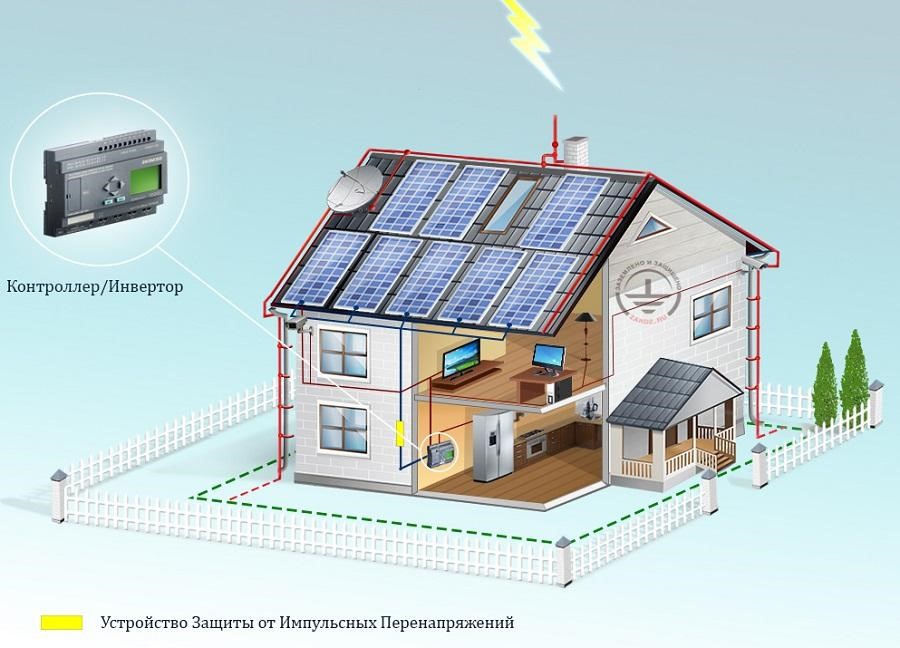
Figure 1. The object equipped with a photovoltaic system
Устройство защиты от импульсных перенапряжений – surge protection device
Major advantages:
- Individual approach in the development of the external lightning protection system - you will be given a technical solution developed in strict accordance with the configuration of your facility and which fully meets modern requirements in the field of lightning protection.
- Modern, durable and easy to install components of external lightning protection.
- Comprehensive solution for surge protection (internal lightning protection) - selection of the SPD protecting the photovoltaic installation in all its most major nodes.
- Unique characteristics of the SPD - our devices limit the overvoltages up to the maximally safe levels.
- Universal devices allow to combine several types of protection in a single package ; this provides compact placement and cost savings.
External lightning protection of an object equipped with a photovoltaic system
First of all, it is necessary to organize a system of external lightning protection, providing coverage of the external part of the photovoltaic system in the protection zone. We wrote earlier how to calculate the protective zone of an external lightning protection.
In addition, it is necessary to take into account some specific features of the object equipped with a photovoltaic system. Lightning rods must be distanced from the solar panels so as to prevent impact of lightning currents on the system. The minimum recommended distance between these elements - 0.5 m (see. Fig.2).
If you cannot keep the recommended distance, you need to perform a direct electrical connection between the external lightning protection system and the frame of solar panels. This is necessary to prevent flowing of equalizing currents through the frame structure of panels. Consequently, the electrical connection must be made only on one side, preferably as close to the down conductor as possible.
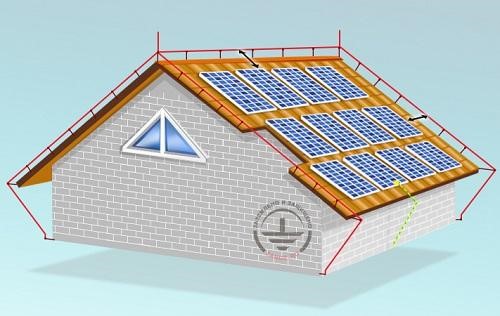
Figure 2. The minimum permissible distances between the external lightning protection and the photovoltaic system
Surge protection* |
In the particular case, there are two main pathways of surges into the system:
- DC network (from the solar panel to the inverter);
- AC network (from the inverter and / or the supply line, if the installation is not autonomous, to the main switchboard).
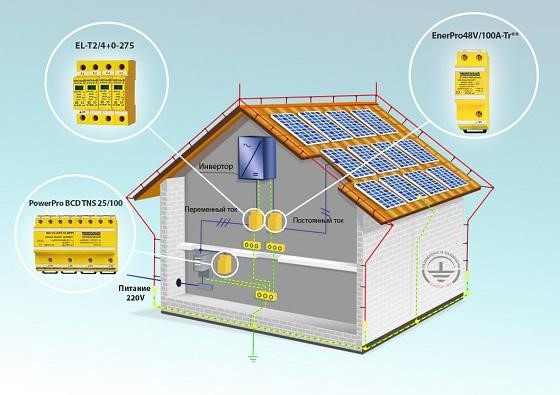
Compliance with the minimum distances from the external lightning protection components to the PV system (see. Fig.2), allows to avoid gettinf of lightning partial currents in the DC circuit***. Accordingly, in this case, it will be right to use SPDs of class 2. (For more information about classification of SPDs you can read here.)
1. Protection of DC network
The most vulnerable and most expensive elements of a photovoltaic system are the controller and the inverter, that is why, first of all, it is necessary to protect them on the DC side.
It should be noted that the nominal voltage of the SPD should be 20% higher tha an open circuit voltage (no-load) of your solar panel. This voltage is counted as the sum of Uoc of each panel (at their consequitive connection). Uoc shall be specified by the manufacturer of solar modules in the specifications.
SPD installation site- before the controller or before the inverter, if it includes controller's functions.
For the use in DC networks, we offer several series of SPDs, designed for a rated voltage from 48 to 1000 V.
| SPD name | Product item | DC rated voltage |
| EnerPro48V/100A-Tr | LE-382-070 | 48 V |
| EnerPro CV 2P 65V/63A-LED | LE-382-080 | 65 V |
| EnerPro CV 2P 100V/63A-LED | LE-382-086 | 100 V |
| CT PV-T2/2-0/600 | LE-960-220 | 600 V |
| CT PV-T2/2-0/1000 | LE-960-222 | 1000 V |
2. AC network protection
For the organization of comprehensive protection it is necessary to install SPD of class 2 at the inverter output (on the AC side). For these purposes, we recommend the use of this device:
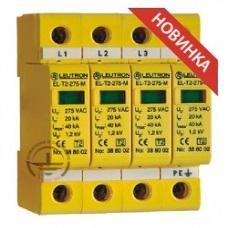 EL-T2/4+0-275 LE-388-109 |
A dangerous surge can get into the equipment from the side of AC power, so we recommend installing a combined SPD PowerPro BCD of class 1+2+3 into the main switchboard. One such device is enough to protect equipment in a small building.****
Depending on how you perform grounding of the protective conductor (TN-C-S or TT scheme), you can select one of the devices suitable for you:
| TN-C-S scheme | TT scheme |
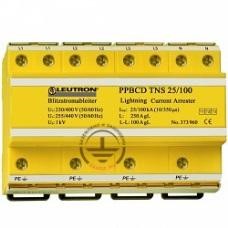 PowerPro BCD TNS 25/100 LE-373-960 |
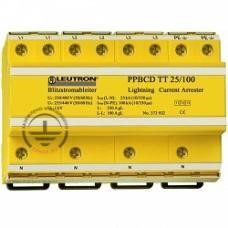 PowerPro BCD TT 25/100 LE-373-930 |
Notes
* The example studies photovoltaic instalations with a capacity of up to 10 kW.
** The example gives a photovoltaic installation with Uoc≤48 V.
*** If the minimum distance is not observed, and the external lightning protection is in electrical communication with the elements of a photovoltaic system, it will be necessary to use SPD of class 1 in the DC network.
**** If you have particularly sensitive equipment, it is possible to install additional SPDs of class 3 into the nearest local switchboards or to use SPDs of class 3, built into a power outlet.
SPDs for the protection of photovoltaic systems
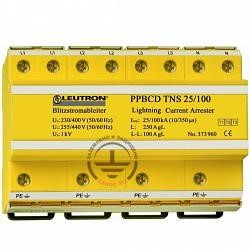
SPD of class 1+2+3 PowerPro BCD TNS 25/100
A unique combined SPD with a very low limit voltage is intended for the use in three-phase networks with neutral mode TN-S (TN-C-S) with the voltage of 220/380 V,
50 Hz.
| LE-373-960 | |
| Maximum lightning impulse current (10/350 ms): | 100 kA |
| Limiting voltage Up (not more): |
1,0 kV |
| maximum working voltage: | 255 V |
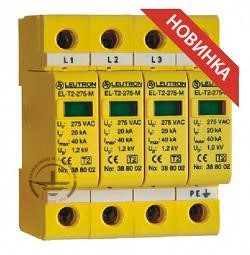
SPDs is intended for use in three-phase networks with neutral mode TN-S
- rated lightning impulse current (8/20 ms) Iimp 20 kA;
- maximum lightning impulse current (8/20 ms) Iimp 40 kA;
- a removable security module.
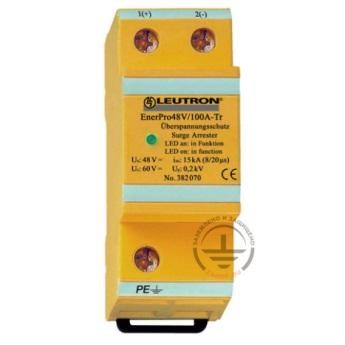
SPDs for use in DC networks with a rated voltage of 48 V.
- High protection level;
- suitable for use in networks with an operating current of up to 100 A;
- no leakage currents;
- mounted on a DIN-rail of 35 mm;
- equipped with a status signalling;
- has multi-functional terminals for various conductors and bars;
- optional contact of remote signaling system (Rk version).
You can see a full range of SPDs on the relevant pages of our website.
Individual selection
This example shows only the most probable pathways of surge overvoltages into a photovoltaic system and describes a general approach to the choice of protective measures and devices.
If your photovoltaic installation has additional power supplies (WPP/ diesel generator / etc.), another wiring diagram (electric network), additional elements, such as low voltage measuring equipment or display panel, and also if the battery system is located at a considerable distance from the place of installation of the SPD of DC, you can always contact our technical center and we'll give you a customized solution that provides comprehensive protection for all of these systems.
The extensive range of the SPDs we offer allows us to choose an individual protection complex that meets all the requirements of reliability and efficiency.
Purchase
You can see the current prices and acquire necessary devices for surge protection in a convenient online store on a separate page "Purchase".

